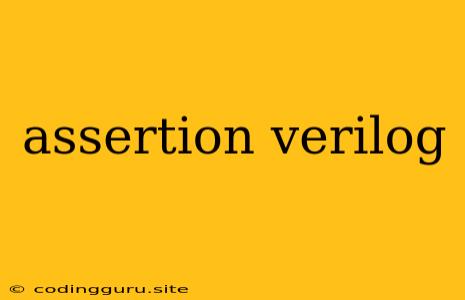Understanding Assertions in Verilog
Verilog, a hardware description language (HDL), is widely used for designing and verifying digital circuits. Assertions play a crucial role in ensuring the correctness and reliability of these designs. But what exactly are assertions, and how do they contribute to the verification process?
What are Assertions?
In essence, assertions are statements that specify expected behavior within a Verilog design. They act as formal checks to ensure the circuit adheres to intended functionality. Imagine them as "guards" that monitor the circuit's state and flag any violations of the defined conditions.
Why Use Assertions?
Assertions bring significant advantages to the verification process:
- Early Detection of Errors: By proactively checking for potential issues during simulation, assertions help identify bugs in the design early on, reducing the risk of costly rework later in the development cycle.
- Improved Coverage: Assertions can target specific corner cases and edge scenarios that might be missed by traditional testbenches, leading to more thorough verification and higher confidence in the design.
- Formal Verification Support: Assertions provide valuable input for formal verification tools, enabling the automatic verification of design properties beyond what can be achieved through simulation alone.
- Design Documentation: Well-written assertions can serve as a clear and concise documentation of the design's intended behavior, making it easier for others to understand and maintain the circuit.
Types of Assertions in Verilog
Verilog offers two primary types of assertions:
- SVA (SystemVerilog Assertions): SVA is a powerful assertion language built on top of Verilog, providing a rich set of operators and constructs for expressing complex conditions. SVA assertions can be used for both simulation and formal verification.
- PSL (Property Specification Language): PSL is another widely used assertion language that offers a similar level of expressiveness to SVA. It is particularly popular for formal verification.
Writing Effective Assertions
Here are some tips for writing clear, concise, and effective assertions:
- Define Clear Expectations: Formulate your assertions in a way that precisely captures the intended behavior. Avoid ambiguity and ensure your expectations are well-defined.
- Keep it Simple: Strive for simplicity and clarity in your assertions. Complex and convoluted statements can be hard to understand and debug.
- Use Well-Understood Syntax: Stick to standard Verilog syntax and avoid using obscure or non-standard constructs.
- Test Your Assertions: Always test your assertions thoroughly with both simulations and formal verification to ensure they correctly identify potential issues.
Example Assertion
Consider a simple design for a 2-bit counter. The following assertion ensures that the counter never overflows beyond its maximum value (3):
assert property (always @(posedge clk) count < 4);
This assertion checks the value of the count register at every positive edge of the clock signal. If the value ever exceeds 3, the assertion will fail, indicating a potential problem in the counter's logic.
Conclusion
Assertions are an essential tool for verifying the correctness and reliability of Verilog designs. By incorporating assertions into your verification process, you can significantly enhance the quality and robustness of your digital circuits. Remember to write your assertions carefully, test them thoroughly, and use them to improve both the simulation and formal verification coverage of your designs.
